#paleontology notes
Text
Fall sem starts in 2 days! Heres my schedule
Intro to Ethnomusicology (Intermediate Seminar) - MWF / 8-8:50am
Dinosaurs: A Natural History - MWF / 9-9:50am
Intro to Biological Anthropology - MWF / 10-10:50am
Intro to Cultural Anthropology - MWF / 11-11:50am
[ LUNCH BREAK ]
Intro to Archaeology - MW / 1-2:15pm
currently can’t get my textbooks because of an issue w financial aid that will hopefully be resolved in the morning. super nervous bc new school and lots of work ahead but also excited for my new major/program and hopefully making more friends :)
#studyblr#langblr#study blog#language learning#langblog#studyinspo#study notes#study aesthetic#study motivation#studyspo#study#anthropology#archaeology#archaeoblr#anthro#cultural anthropology#biological anthropology#dinosaurs#paleontology#paleoblr#paleoanthropology
51 notes
·
View notes
Text
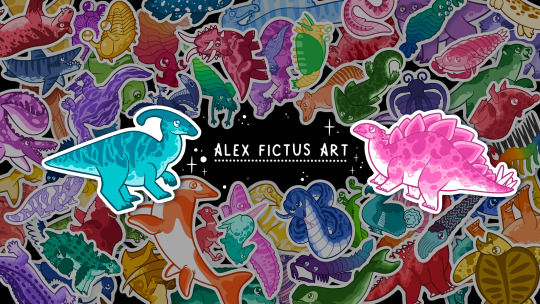
✨Paleo Party Stickers - Patch Notes 1 ✨
Added to Cambrian Era Group: Eldonia
Added to Carboniferous Era Group: Megarachne
Added to Jurassic Era Group: Hybodus, Miragaia, Chungkingosaurus, Gigantspinosaurus, Kentrosaurus, Yi Qi
Added to Cretaceous Ornithischians Group: Wuerhosaurus, Chasmosaurus, Medusaceratops, Centrosaurus, Gryphoceratops, Torosaurus, Atlascoposaurus, Shantungosaurus, Olorotian, Zalmoxes
Added to Cretaceous Saurischians Group: Siamosaurus, Ceratosuchops, Iberopsinus, Vaillabonaventrix, Sigilmassasaurus, Riparovenator, Gigantoraptor
Added to Cretaceous Non-Dinosaurs Group: Repenomamus, Sterpodon
Removed from Cretaceous Non-Dinosaurs Group: Hybodus
Added to Neogene Era Group: Chalicotherium, Deinotherium
Added to Quaternary Era Group: Gigantopithecus
Added to Holocene Era Group: Passenger Pigeon, Alligator Gar, Pelican, Horseshoe Crab, Triops
✨📈Upcoming Queue 📈✨
With pride coming up and the pride cats needing video editing, I may not hit all of these but these are my next priority groups!
Thyreophorans: Jakapil (K), Gastonia (K), Akinacephalus (K), Edmontonia (K), Tarchia (K), Gargoyleosaurus (J), Scelidosaurus (J)
Sauropods: Magyarosaurus (K), Xinjiangtitan (K), Saltasaurus (K), Brontosaurus (J)
Theropods: Saurophagnax (J), Monolophosaurus (J), Metricanthosaurus (J), Albertasaurus (K), Struthiomimus (K), Incisivosaurus (K), Atrociraptor (K), Bambiraptor (K), Maip (K)
Pterosaurs: Rhamphorhynchus (J)
Ediacaran: Mawsonites, Spriggina, Dickinsonia, Charnia
Paleozoic misc: Cyclida (C), Goniatites (C), Bulbasaurus (P), Diictodon (P)
Mesozoic misc: Juramaia (J), Thalattoarchon (T), Nothosaurus (T)
Cenozoic misc: Dinictis (Pg), Argentavis (N), Pelagornis (N), Toxodon (N), Nuralagus (N), Teratornis, (Qu), Platygonus (Qu), Tuatara (Living Fossil), Tanuki (Living Fossil)
This was a pretty big update! Next sticker patch notes will probably be the upload of the pride cats! If you have any recommendations or requests for the paleo party, send me a message!
All pride cats have been decided and I'm about to start printing them all for my May shop update on Friday May 3!
Date: April 2, 2024
15 notes
·
View notes
Text

my beloved son
#viviposting#funny#paleontology#meme#he would be best friends w the fresno nightcrawlers#genuinely i need this to breach containment#if none of my other posts ever get more than 1k notes i want this one to#i need stickers of this thing
6 notes
·
View notes
Text
Maybe the real compsognathids were the friends we made along the way.
5 notes
·
View notes
Text
I'm a college student- you would think that means I have decent note taking habits.
I needed to go through one of my notebooks from last spring tonight. Here are some highlights of my note taking process.

Character design for hermits and also some oc doodles
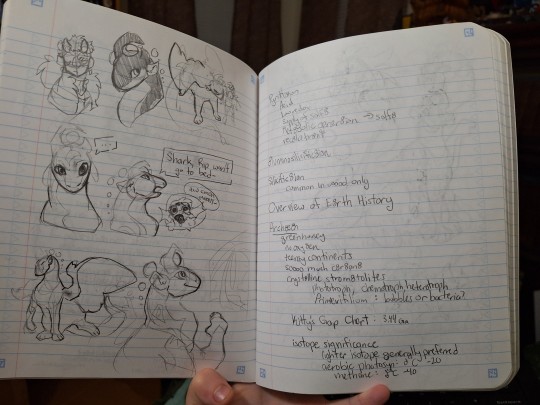
LOTS of OC doodles. Just having fun with my dragon ocs.
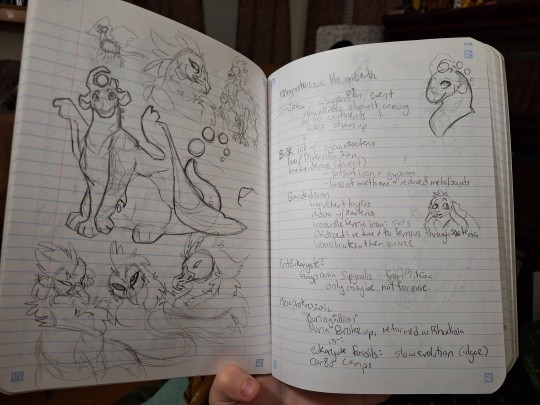
More of the same dragon OC. also character design for different, unrelated OCs.
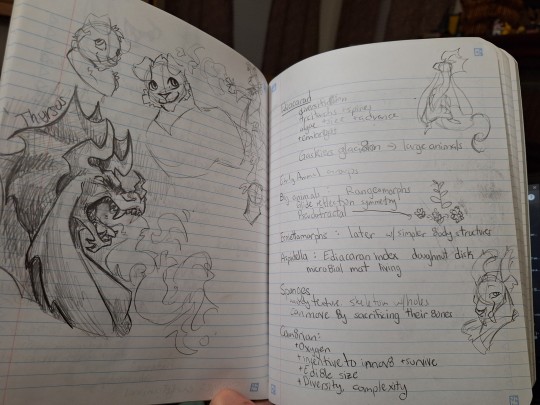
Whole illustration of another dragon OC. Also firestar warrior cats character design.
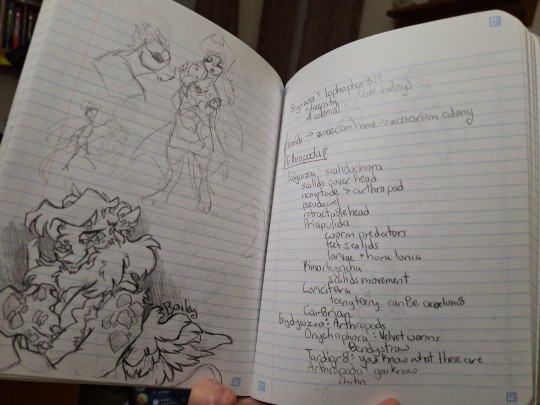
And last but CERTAINLY not least another clean drawing of an OC in addition to several doodles of other characters in her world.
And yes. If you try to read the notes themselves you'll notice that. They were in fact written in vriska's typing quirk. I'm not ashamed of that.
#me vibing#my art#technically i guess????#these notes may have been a year ago but.#this is still how i take notes. tbh i mightve gotten worse even#i'm not on this path anymore-- the path of paleontology that is --but.#it's really funny to me how bad my note taking can be sometimes. in exchange for some of my best art???#like hello????? i forget sometimes how good my art can be when i'm using it as a stim#and not as . me trying to do art lmao
3 notes
·
View notes
Text
💕💚I love you Utahraptor I love you Fruitadens I love you Camarasaurus I love you Allosaurus I love you Dryosaurus I love you Peloroplites I love you Nanosaurus I love you Stegosaurus I love you Animantarx I love you Camptosaurus I love you Brachiosaurus I love you Lambeosaurines I love you Chasmosaurus I love you Prosaurolophus I love you Stegouros I love you Gastonia I love you Eolambia I love you Fulcarius I love you Mymoorapelta I love you Therizinosaurus I love you Deinocheirus I love you Anchiornis I love you Borealapelta I love you Sinosauropteryx I love you Albertasaurus I love you Velociraptor I love you Mononykus I love you Torosaurus💚💕
75 notes
·
View notes
Text
Fossil Formation

ko-fi
21 notes
·
View notes
Text

/X/ musing on spinosaurus and by extension the field of paleontology & archeology as dialectical ontology.
In other words-- The history, behavior, and perception of how this creature lived and what it looked like in pop culture being a psychic projection of the paleontologist based on subconscious biases influenced by contemporary media. Even those aware of their biases are incapable of escaping them, as any alternative hypothesis ultimately only emerges as a reaction to those biases. Spinosaurus, when discovered, was imagined only in the context of Tyrannosaurus as the most well know therapod. All reimagining of it after could only be a revolt against that perception.
... Just something to think on while I do my world building around an alternative prehistoric timeline set in the mythos. Any ideas I come up with are without exception inherently limited by what I as a human am able to conceptualize based on what exists in my contemporary world and anything that doesn't might as well have never existed. It's in those blanks that you let your players loose, assembling the spinosaurus from the bones it left behind.
18 notes
·
View notes
Text
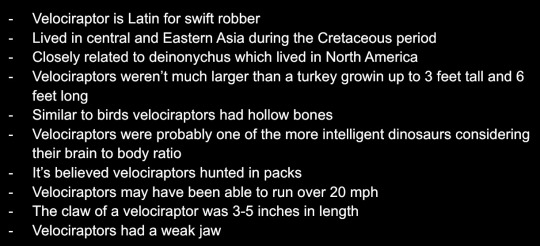
#studyblr#study notes#paleontology#dinosaurs#velociraptor#theres a surprising lack of information on velociraptors
3 notes
·
View notes
Text
Mod 2: Pteridophytes
Internal Structure of Lycopodium
Root:
A T.S. of root shows 3 distinct regions:
Epidermis: Single layered made up of thin walled cells.
Presence of unicellular root hairs.
Root hairs in lycopodium arise in pairs.
Cortex: Composed of parenchymatous cells.
On older roots, the outer layer of cells of cortex became thick walled and provide support.
Stele: The central part of the root is occupied by a protostele which is monarch in young roots but became diarch or triarch in older roots.
The xylem is C-shaped and phloem lies in between the arms of the xylem.
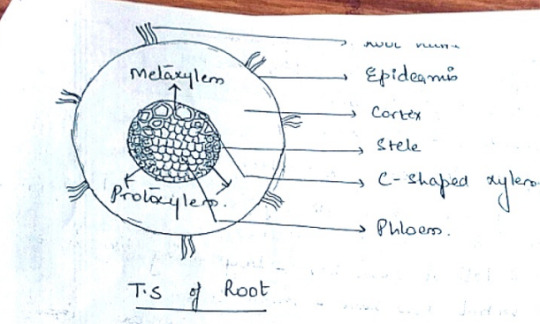
Stem:
Stem is also differentiated into epidermis, cortex, and stele.
Epidermis: Forms the outermost protective layer. The outer walls are thick and cutinized.
Stomata present in epidermis of young stem.
Cortex: The structure of cortex varies depending on the species and stem diameter.
It is homogenous - remains parenchymatous through out.
Shows distinct tissue zonation - chlorenchymatous hypoderm, sclenchymatous around the stele, and parenchymatous between above 2 zones.
The innermost layer of cortex forms endodermis followed by 2-6 layered pericycle composed of thin walled cells.
Stele: All the species of lycopodium have protostele but they differ in the arrangement of xylem, phloem, and the parenchyma cells:
a) Plectostele: Xylem and Phloem occur in parallel rows separated by parenchyma.
b) Actinostele: Presence of star shaped xylem and phloem in between the arms of xylem.
c) Mixed Protostele: In few species, xylem and phloem cells are uniformly intermixed.
The xylem is differentiated into protoxylem and metaxylem elements exarch condition.
There is no cambium between xylem and phloem and hence no secondary growth.

Leaves:
The leaf is triangular in outline.
Epidermis is covered with thick cuticle.
Most of the species are amphistomatic, i.e. stomata are distributed uniformly on both the surfaces.
Few species are hypostomatic, where stomata are confined to the lower surface.
The mesophyll is undifferentiated and consists of chlorophyllous cells with large intercellular spaces.
The leaf has median concentric vascular bundle with central xylem surrounded by phloem.
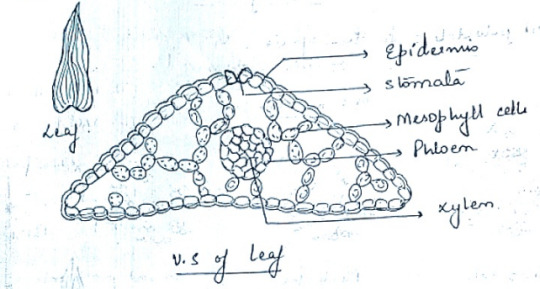
Internal Structure of Equisetum
Aerial Shoot:
The anatomy of the stem shows a combination of hydrophytic and xerophytic characters. The nodes and internodes have different internal structures.
a) Internode: A T.S. of internode is wavy in outline due to the presence of ridges and grooves. It has epidermis, cortex, stele, and central pith.
Epidermis: Composed of single layers of cells with heavy deposition of silica (on both outer walls and also the radial walls).
Epidermis is interrupted by stomata that are usually confined to the grooves.
Stomatal apparatus is composed of (fom??) cells arranged in 2 tiers of 2 cells each.
Cells in lower tier = Guard cells
Cells in upper tier - Subsidiary cells
These stomata are generally sunken but in one species they are at the level of the epidermis.
Cortex: Differentiated into an outer and an inner region.
Outer cortex has several layers of sclerenchymatous cells which provide mechanical strength and a layer of chlorenchymatous cells which provide photosynthetic regions of shoot.
Inner cortex has parenchymatous cells. It has large canals known as vallecular canals, below the furrows. These canals extend throughout the length of the internode and form an aerating system.
Endodermis: Cortex is delimited from the stele by an endodermis which varies in position:
i) E. palustre has a single layer of endodermis outside the stele.
ii) E. debile has two endodermal layers, an outside stele and one on inner side of the stele.
iii) E. giganteum has layers around each vascular bundle.
Pericycle: Endodermis is followed by a single layered pericycle of parenchymatous cells.
Stele: The vascular cylinder is a siphonostele, where vascular bundles are arranged in a ring around the large pith.
The vascular bundles lie in position alternate to the vallecular canals and lie opposite to ridges.
The bundles are conjoint, collateral, and endarch.
In a mature vascular bundle the protoxylem elements disintegrate to form a conspicuous protoxylem lacuna called carinal canal. Some of the protoxylem elements, however, can be seen along the periphery of the carinal canal. Metaxylem tracheids have scalariform, reticulate, and pitted thickenings.
Phloem lies outside the xylem and in radial alignment with carinal canal. Made up of sieve tubes and phloem parenchyma.
Carinal canals are filled with water and help in the conduction of water whereas vallecular canals have only air.
Pith: The central region is occupied by a large pith cavity.
In some species, pith is absent.
The internode shows the following:
Xerophytic features:
1. Presence of ridges and grooves.
2. Outer and radial walls are impregnated with silica.
3. Presence of sunken stomata.
4. Presence of well developed sclerenchymatous hypodermis.
5. Presence of well developed vascular cylinder.
Hydrophytic features:
1. Presence of well developed aerating system, i.e., vallecular canals and central pith cavity.
2. Presence of reduced xylem, represented by few protoxylem and metaxylem tracheids only.

b) Node: The internal structure of the node differs from the internode in the following features:
1. Pith is not follow in the mode and instead a nodal diaphragm is present.
2.Vallercular canals are usually not present.
3. Vascular bundles fuse together and form a vascular cylinder around the nodal diaphragm.
4. Carinal canals are absent.
5. Leaf and branch traces arise from the vascular cylinder of the node.

Rhizome
The internal structure of the rhizome differs from the aerial shoot in the following features:
1. Epidermis without stomata.
2. Outer cortex is less sclerenchymatous.
3. Cortex without chlorophyllous cells.
4. The vallecular and carinal canals are marrow in comparison to those in aerial shoot.
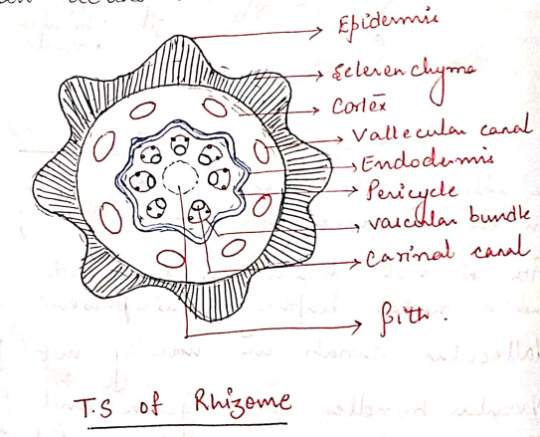
Root
Transverse section of the root shows epiblema, cortex, and stele.
Epiblema: The single layered epiblema forms the outermost protective covering of the root. Some sells elongate to form root hairs.
Cortex: Epiblema is followed by a wide cortex.
Outer cortex is sclerenchymatous (exodermis) while inner cortex is parenchymatous (has intercellular spaces)
Endodermis: A characteristic feature of the root of equisetum is the presence of a 2 layered endodermis.
In outer endodermis the cells are larger with casparian bands while in inner endodermis the cells are smaller without casparian bands.
Pericycle is absent and lateral roots arise from inner endodermis.
Stele: A protostele is present in the center of the root with diarch to tetrarch xylem. The number of xylem strands usually increases with the diameter of the root.
A large metaxylem tracheid is present in the center of the stele and the protoxylem strands lie around it. The phloem is present in between the protoxylem strands.
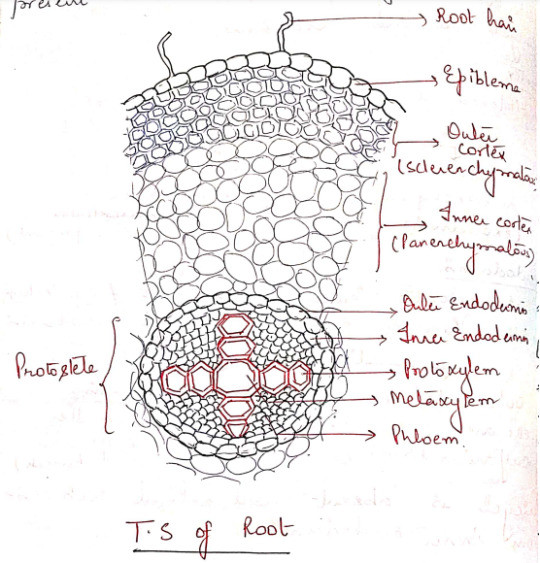
Internal Structure of Marsilea
Rhizome
The transverse section of the mature rhizome shows the following structures:
Epidermis: Single layer of compactly arranged thick walled cells. It does not have stomata.
Cortex: Made up of three layers:
Outer cortex is composed of parenchymatous cells with air chambers called arenchyma. Air chambers are separated from each other by single layered septum - Trabeculae.
Middle cortex is made up of sclerenchyma cells.
Inner cortex is made up of parenchyma cells.
Stele: The vascular cylinder is an amphiphloic siphonostele. Xylem is surrounded both externally and internally by phloem, called outer phloem and inner phloem respectively.
The outer endodermis and pericycle surround the stele externally and the inner endodermis and pericycle internally. All these layers are single layered.
The central part of the stele is occupied by a sclerenchymatous pith.
In xerophytic species, pith is sclnotic(??) and air chambers are not present in the outer cortex.

Petiole:
The petiole is also differentiated into:
Epidermis: Single layer of compactly arranged rectangular cells.
Cortex: Differentiated into outer arenchymatous cortex and inner parenchymatous cortex.
The inner cortex contains starch grains and few cells contain tannins.
Stele: Surrounded by a layer each of endodermis and pericycle. Endodermal cells are characterized by the presence of companion(??) bonds.
The xylem consists of 2 strands, each forming a curved arch. The 2 arches are closer to each other in the middle but then outward on either side.
The metaxylem is present towards the base of the arch while the protoxylem towards the apex.
The xylem is surrounded by phloem. Pith is absent. Haplostele(why is this word here)
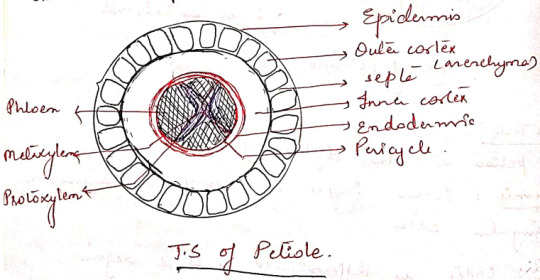
Leaf/Leaflet
The section of the leaflet shows mesophyll tissue sandwiched between two epidermal layers. Both the upper and lower epidermis are single layered and covered by cuticle.
Epidermis is interrupted by stomata.
Aquatic floating species: stomata is confined to upper epidermis.
Terrestrial species: stomata present on both layers.
Mesophyll is differentiated into 2:
Palisade parenchyma: made of compactly arranged cells in 2 layers below epidermis.
Spongy parenchyma: cells are loosely arranged with intercellular spaces.
Mesophyll is not differentiated in submerged aquatic species.
The vascular bundles are concentric, with a central xylem surrounded by phloem. Each vascular bundle is surrounded by a layer of endodermis.
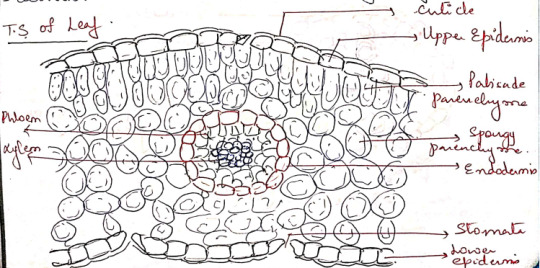
Root
The transverse section of root shows 3 distinct regions:
Epidermis: Composed of single layered cells that are compactly arranged.
Cortex: Differentiated into 3 layers:
Outer cortex is arenchymatous. Air chambers arranged in a single row.
Middle cortex is of thin walled parenchymatous cells.
Inner cortex is made of sclerotic cells.
Stele: The stele is surrounded by a later each of endodoermis and pericycle.
The xylem is diarch and exarch. It has metaxylem element in the center and protoxylem elements towards the periphery.
The phloem is present on either side of xylem.
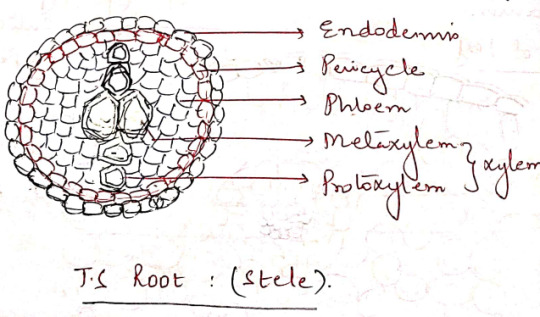
Rhynia
Classification
Class - Psilopsida
Order - Rhyniales
Family - Rhyniaceae
Genus - Rhynia
Occurrence
The name of the genus Rhynia is derived from the place "Rhynie' in Scotland.
Rhynia is a fossil obtained from peat deposits.
Rhynia was a primitive vascular plant that grew in swampy marshes. Because of volcanic eruption, rhynia became a petrified fossil. (embedded and impregnated with silica)
Species of Rhynia: R. major.
Sporophyte/External Morphology
The plant of Rhynia was a sporophyte. It grew up to a height of 20cm.
The plant body is differentiated into 3 regions: a horizontal rhizome, leafless aerial shoots arising from the rhizome, and rhizoids.
The leafless aerial shoots are dichotomously forked. Elongated sporangia were present at the tips of few branches.
Rhizoids are present on the underside of the rhizome in patches.
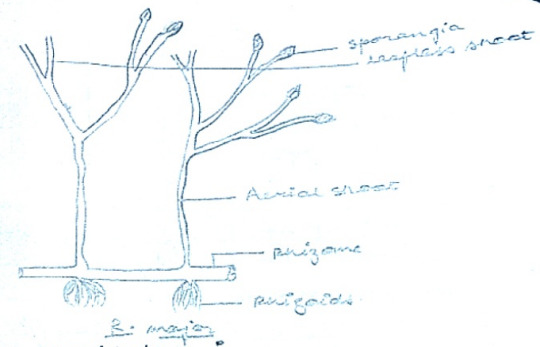
Internal Morphology
The internal structure of rhizome and aerial shoot was similar.
It was differentiated into:
Epidermis: Single layered cells. The aerial stem epidermis is covered with cuticle and shows stomata; rhizome has no stomata.
Cortex: further differentiated into outer and inner cortex:
Outer cortex: aka hypodermis, 1-3 layered parenchymatous cells without intercellular spaces.
Inner cortex: parenchymatous cells with intercellular spaces. The chief photosynthetic tissue of the plant.
Stele: Protostele, cylindrical mass of xylem surrounded by phloem.
*insert diagram, it's literally just a xylem circle inside a larger phloem circle*
Reproductive Structures
The sporangia were borne at the tip of the aerial shoots.
They are simpler in structure.
It was cylindrical in shape with broad base and slightly narrow apex.
The sporangium has a jacket (several cells in thickness). It is covered with cuticle. There was no columella in the center.
The sporangial cavity contained many spores (homosporous).
There is no specific dehiscence mechanism and the spores are released only after the decay of the jacket layer.
The innermost layer of jacket acts as Tapetum.
The gametophyte of Rhynia is not known.

Phylogenetic Significance of Rhynia
Rhynia and other members of Rhyniaceae represent the most simple and oldest vascular plants.
The organization of the plant body is algae like, but due to the presence of vascular system, it is not included in thallophytes.
If the sporangia and the aerial shoots were the only known portion of the plant body, one would assign it to bryophytes.
Zimmermann, in his telome theory, holds that the primitive shoot was upright, dichotomously branched, leafless, and similar to that of Rhynia.
He called the ultimate dichotomies as the "telomes."
The structural attributes of Rhynia like photosynthesis performing shoot, thick cuticle, developed stele, and presence of stomata clearly indicate that this plant cannot be considered the first land plant.
Some believe that the plants of Rhyniaceae became reduced due to unfavorable environmental conditions.
Telome Theory
Telome theory was first proposed by Zimmermann in 1930. According to his theory, vascular plants have evolved from a simple, leafless, rootless, and dichotomously branched sterile and fertile axes called telomes. which originated from radially symmetrical and dichotomously branched algal ancestors.
The other plants developed leaves, roots, sporangia, and other organs by modification and differentiation in telomes.
Zimmermann termed the extreme terminal portions of plants, having single nerves, as telomes and the internodes below it as mesomes. The telome may be fertile, having single terminal sporangium or sterile without sporangia.
According to this theory, various organs like leaves, roots, sporangia, etc. have evolved from the simplest and earliest vascular plants by 'progressive differentiations' called Elementary processes. They are:
1. Overtopping: During this process, the 2 sister branches of a dichotomy or telome truss become unequal.
One of them grew stronger and became erect, while the other became weaker and pushed aside.
The stronger branch -> became axis
The weaker branch -> became lateral appendage or leaf.

2. Planation: During the process the axis divided dichotomously in more than one planes. These branches were arranged in single plane and have rise to leaves.

3. Syngenesis/Webbing: During this process the telomes and mesomes become fused by the formation of parenchymatous webbing between them. This resulted in the formation of:
i) leaves with dichotomous venation
ii) leaves with pinnate venation
iii) leaves with reticulate venation
iv) shoot with various stele types

4. Reduction: Simplification and reduction of telome truss resulted in the formation of microphylls and needle shaped leaves.

5. Incurvation: During this process, the fertile telomes were reflexed so that the sporangia became inverted in position.
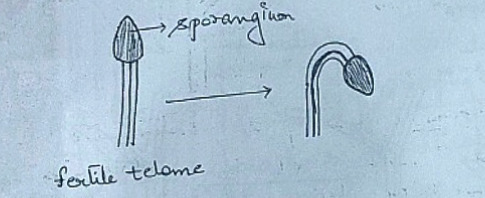
Origin of Leaves
According to Zimmermann's theory, the microphyllous leaves (as in lycopodium) originated by the process of reduction and the megaphyllous leaves (as in marsilea) originated by combined processes of overtopping, planation, and syngenesis.
Origin of Sporophylls: Zimmerman gave 3 different lines of evolution in three main divisions of pteridophytes:
Origin of Sporophylls in Lycopodium:
The sporangia in the members of lycophyta are usually born in the axils of the microphyllus sporophylls.
It resulted in aggregation of fertile and sterile telomes, followed by reduction in the mesomes and the number of sporangia.
It resulted in the formation of single sporangium in the axil of single sporophyll.

Origin of Sproangiophores in Equisetum:
The members of this division are characterized by having sporangia borne on peltate sporangiophores.
The sporangiophores originated by the combined process of
i) Overtopping and reduction in the fertile segments resulting in whorled arrangement.
ii) Reduction of fertile branches leading to the downward bending of the sporangia.
Syngenesis of telomes and mesomes heading to the formation of peltate sporangiophores.

Origin of Sporophylls in Marsilea:
Megaphyllous sporophylls of marsilea were evolved by the combined processes of overtopping, syngenesis, reduction, and incurvation
Overtopping resulted in the formation of pinnate sporophylls.
Syngenesis of mesomes resulted in formation of the marginal sporangia.
Incurvation resulted in shifting of marginal sporangia to the lower surface of the sporophylls.
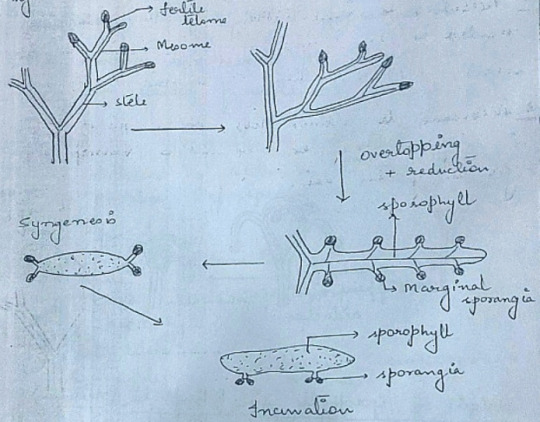
Merits of Telome Theory
Clearly explains the origin and evolution of sporophytes of vascular plants.
This theory is based mainly on the comparative study of fossil as well as living genera of vascular plants.
Most of the assumptions are based on the phylogenetic relationships between various groups of plants.
The elementary processes clearly explain the the manner of evolution of vascular plants.
Demerits of Telome Theory
According to Bower in 1946, the theory took for granted the telome as a fundamental unit without explaining the characteristic development.
According to Eames in 1936, the origin of leaves in lycopodium can be regarded as simple out-growth of the axis.
#exam season#send help#biology#notes#science#botany#plants#pteridophyte#plant science#paleobotany#paleontology#fossils
1 note
·
View note
Text
Contenido Curricular Licenciatura Criminología y Criminalística
Primer Cuatrimestre
◦Teoría del conocimiento científico ✓
◦Diversidad Cultural del Estado ✓
◦Ética y Valores✓
◦Proyecto de nación (Perspectiva Histórica)✓
◦Filosofía del Pensamiento humanista contemporáneo✓
◦Seminario de habilidades para el trabajo intelectual✓
Segundo Cuatrimestre
◦Bases biológicas de la conducta ✓
◦Introducción al estudio del derecho ✓
◦Investigación Criminal ✓
◦Sociología Criminal ✓
◦Criminalística de campo ✓
◦Liderazgo, toma de decisiones y trabajo Criminológico en equipo ✓
Tercer Cuatrimestre
◦Medicina forense I ✓
◦Derecho Penal✓
◦Política Criminal ✓
◦Derecho Civil ✓
◦Criminalística de laboratorio✓
◦Taller de levantamiento y embalaje de indicios ✓
Cuarto Cuatrimestre
◦Medicina Forense II✓
◦Derecho Procesal Penal ✓
◦Criminología I ✓
◦Antropología Forense
◦Dactiloscopia Forense ✓
◦Taller de traducción y comprensión de la lengua extranjera aplicada ala criminología I✓
Quinto Cuatrimestre
◦Psicología Criminal I
◦Derecho penal (delitos en especial)
◦Criminología II
◦Penología y Derecho Penitenciario
◦Grafoscopía y documentos copia
◦Taller de Traducción y comprensión
de la lengua extranjera aplicada ala Criminalística II
Sexto Cuatrimestre
◦Psicología Criminal II
◦Derecho Constitucional y Derechos Humanos
◦Criminología Clínica
◦Delincuencia Organizada y Delincuente serial
◦Metodología de la investigación Criminalística
◦Observación y practica criminalística
Séptimo Cuatrimestre
◦Química y Toxicología forense I
◦Teoría General del Delito
◦Victimología
◦Investigación Monográfica y exposición en clase
◦Balística Forense
◦Observación y Practica Criminalística
Octavo Cuatrimestre
◦Química y Toxicología forense II
◦Delincuencia y responsabilidad Juvenil
◦Criminología Penitenciaria
◦Seminario de elaboración de tesis I
◦Casualidad de los hechos de tránsito
◦Taller sobre sistemas forense
Noveno Cuatrimestre
◦Biología Forense
◦El sistema acusatorio
◦Estadisticas Delictivas
◦Seminario de elaboración de tesis II
◦Incendios y explosiones
◦Coordinación e Inteligencia Pericial de indicios forense
#criminalistica#criminologia#medicina forense#linguistics#original art#motivation#paleontology#notes
1 note
·
View note
Text
as a huge fan of paleontology, that one borealopelta fossil makes me so fucking emotional. just look at this

this isn't just fossilized bone. this is a fossilized body. it looks less like a several-million-year-old specimen and more like a living, breathing animal that simply fell asleep.
also of note, this particular fossil was preserved in three dimensions, rather than having been flattened over time like the majority of fossils that you would typically find. a lot of specimens look more like an imprint than anything else. but this has depth, and volume. and its so detailed that researchers have been able to determine its skin color based off the compounds found on the surface.
idk it just really makes me want to burst into tears. so much of paleontology relies on making inferences from bones and a variety of trace fossils, and there are likely several details about prehistoric fauna that we simply don't know because they dont fossilize well, and fossilization is already an incredibly rare process as is.
for example, if spiders all died out before humans ever saw any, and all we had left were fossils, would we know they spun webs of silk? would the spinnerets be enough to tip us off?
there are so many things we still don't know about prehistoric life, and likely never will know because it wasn't preserved. can you imagine how many species we just don't know about because they never fossilized?
but here, with borealopelta, we have such a well-preserved specimen that it looks as though it could wake up at any second. It just makes me feel something inexplicable.
#paleontology#dinosaurs#borealopelta#sorry sometimes i have to ramble about prehistory#if i wasnt an artist i probably wouldve gone into paleontology lmao
8K notes
·
View notes
Text

[ The skull is mounted on a custom steel armature, which allows for it to be seen all the way around. ]
"After seven years of work, the best preserved and most complete triceratops skull coming from Canada — also known as the "Calli" specimen — is on display for the first time since being found in 2014 at the Royal Tyrrell Museum in Drumheller, Alta.
A museum news release calls the specimen "unique" because of where it was discovered, the age of the rock around it, and how well it was preserved.
Following the floods that tore through Alberta about 10 years ago, the Royal Tyrrell staff were engaged in flood mitigation paleontology work when the triceratops skull was discovered in 2014.
Triceratops fossils are rare in Canada. This skull was found in the foothills of southwestern Alberta — an area where dinosaur fossils in general are uncommon — and nicknamed "Calli" after Callum Creek, the stream where it was discovered.
Transported via helicopter in giant, heavy chunks, the skull and most of the jaw pieces were extracted over the course of a month in 2015. The rest of the triceratops' skeleton was not found.
Roaming the earth roughly 68 to 69 million years ago, the museum says this skull was buried in stages, evident by the fossilization process.
"Paleontologists know this because the specimen was found in different rock layers, and the poorly preserved horn tips suggest they were exposed to additional weathering and erosion," reads a museum blog about the triceratops skull.
"The rest of the skeleton likely washed away," noting that the lower jaws were found downstream.
From 2016 to 2023, Royal Tyrrell technician Ian Macdonald spent over 6,500 hours preparing this fossil, removing over 815 kilograms of rock that encased the skull. This triceratops skull is the largest skull ever prepared at the museum and its third largest on display."
Read more: "Canada's biggest and best triceratops skull on display in Alberta" by Lily Dupuis.
#palaeoblr#Palaeontology#Paleontology#Dinosaur#Triceratops#Fossil#Cretaceous#Mesozoic#Ceratopsian#Extinct#Prehistoric#Photo#Article#Information#Museum#Royal Tyrrell Museum
2K notes
·
View notes
Text
More fun Calvin and Hobbes facts!
Not only is Hobbes NOT an imaginary friend by word of the comic's creator, Bill Watterson, but he doesn't seem to know what an imaginary friend is, nor that plush toys in general are actually toys; Susie Derkins (a girl Calvin has complicated feelings about and tends to randomly alternate between prosecuting a rivalry between the two of them and seeming to regard her as a friend or at least someone he bothers talking to) has a plush bunny she calls Mr Bun, and Hobbes at one point notes with some concern that he seems comatose.
The comic was well known for its lavish backgrounds, and two chiefly notable examples include the woods around Calvin's house and the landscapes of his imagination; in the former, he and Hobbes often go exploring, sledding or racing around on a little red wagon, often while expressing philosophical insights (usually ending in Calvin crashing into something in a way that underscores the point of the dialogue).
On that above note, in the latter case, Calvin often imagines elaborate and fanciful settings such as alien worlds, and the tone of a lot of these vary between comedic bits of Calvin pestering people by shooting them with darts while his fantasy portrays him as a space hero fighting horrible blobby creatures.
Calvin And Hobbes probably wasn't the FIRST comic strip to follow then-current paleontological debates and scientific course, but it was written at the exact right time of increasing interest in dinosaurs as public consciousness accepted the image of them as clever, quick-moving and fierce creatures instead of the slow-moving brutes doomed to die out from earlier perspectives; while the comic initially did depict them as something akin to retrosaurs, this died away very quickly and the comic was an entry point for becoming a Dinosaur Kid for a lot of people i think
There is often a division between the vibrantly illustrated worlds of Calvin's imagination against the much more dull visuals of school he has to deal with; he frequently has trouble with his school work, he's EXTREMELY prone to acting out and causing mischief at school, and school is often portrayed as a dull, exhausting and tiring thing he hates above everything else. His fantastical worlds are fun and lovingly illustrated; the world he has to actually deal with is at best tiring.
Hobbes is essentially his only friend. Calvin doesn't really seem to want to deal with other people at all (he seems to find it difficult at best and the few times he does, he comes off as out of his depth and uncertain). While he pesters Susie at the best of times, she is also notably the ONLY person he goes out of his way to talk to at all, and some of his comments to her are strongly revealing.
Calvin himself is an EXTREMELY intelligent kid, often discussing deeply philosophical stuff, and its frequently brought up that no one knows why he struggles with schoolwork as much as he does. At one point Susie even raises the question and he gloomily replies that he finds his life is easier if he lets everyone's expectations for him be as low as possible. Interpretations have ranged from him being an undiagnosed kid on the autistic spectrum (not unlikely, given this was written from the mid 80s to mid 90s) to simply reflecting the anxieties of school for many kids of the era.
This strip exists:
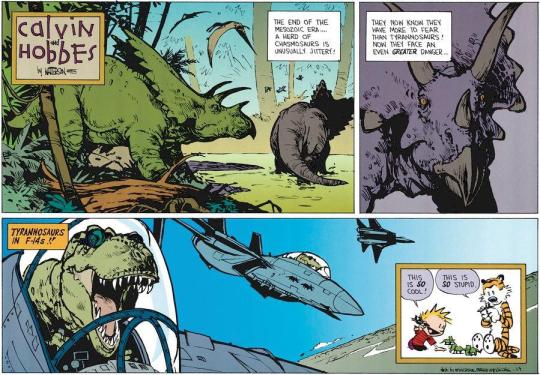
289 notes
·
View notes
Text
roommate!ellie headcannons.
pairing : ellie williams x reader
pov : second person , she/her pronouns
warnings : mention of porn i guess? college!ellie!! she’s got a big fat crush on you
notes : PLEASEEE send me headcannon and blurb requests for ellie (AND ABBY)!!

roommate!ellie that you met in a facebook group (she promptly deleted facebook as soon as you met)
roommate!ellie who refuses. and i mean re fuses. to do laundry.
she hates it oh my god she hates it. she does dishes, you do laundry. that is the agreement!
roommate!ellie who does not care what the place looks like, please take all creative control. she’ll love it regardless
she WILL kick ice under the fridge no matter how many times you tell her not to
roommate!ellie who would rather die than forget to water your plants. because she knows you love them and she KNOWS you will forget
she’s so “dad who says he doesn’t want a cat but loves that cat more than himself”
(the cat’s name is star. i will not elaborate.) (savage starlight.)
roommate!ellie who introduced you to fortnite and is mad because you’re better than her
roommate!ellie whose love language is physical touch
she will Die if your legs aren’t in her lap while watching a movie. she will sit on the counter beside the stove if you’re cooking.
roommate!ellie is a LOOOOSERRRRR
i’m talking sweating when you’re wearing pajama shorts, shaking when you play with her hair, blushing like all the fucking time.
she needs you bad.
roommate!ellie who turns into a handyman any time something breaks (she will break it more than it was already broken)
she was laying on the kitchen floor tiles when she accidentally broke the ac
roommate!ellie who refuses to let you buy groceries
“i eat more than you anyway” “you pay for the netlifx and the disney+” “let me sugar momma you”
roommate!ellie who will get on. All fours. if she comes home from work or class and you’re cooking or you made dinner for her.
(please please please be her housewife) (omg who said that?!)
roommate!ellie who puts cream and sugar in her coffee even though she likes black the best
because she knows she won’t finish the mug but you will and you like cream and sugar
roommate!ellie who is actually not! an astronomy major! she’s a paleontology major for sure
roommate!ellie who spends every paycheck she gets on 1. groceries and 2. random little trinkets she knows you’ll like
the sonny angel collection is crazy (thank you ellieeee :P)
roommate!ellie who can not stop giving you weird nicknames
“sweet girl” “angel” yeah yeah the normal ones but why is she calling you “beef” and “charcuterie board”
roommate!ellie was the first person you smoked with and she almost cried because she felt so bad when you greened out
her music taste is so. Bad (comedically, she actually has really good music taste)
“ellie if you play mask by dream one more time i’m going to [TRAIN PASSES BY]”
roommate!ellie (loser) who says “can i put my minecraft bed next to yours” LOSER
roommate!ellie who is So fucking smart but she pretends to not know what’s going on in her classes so you will sit next to her and your upper arm will touch hers as you help her
roommate!ellie who has to be constantly reminded to close her bedroom door at night
“i don’t know if you’re getting laid or watching p*rn but Hey close the door”
(you’re not jealous. why would you be jealous? it’s not like you like ellie or anything so if she’s getting laid why would it matter you don’t-)”
:0
roommate!ellie who worships the ground you walk on
do Not try on a dress or a skirt or a cropped shirt in front of her because she will pass out and d*e
stuttering and shit when you ask about her day (say it with me) (loooserrrr)
roommate!ellie who will Not hang up the phone or say goodbye without saying “love you”
cuz she does :,) she loves you :,)
don’t say “love you too” though because she will overthink it and stress herself out to tears
roommate!ellie who annoys dina so bad with how much she talks about you
“i was talking to y/n and she said” “y/n really likes this show” “y/n said that we should”
“oh my job just fuck already”
ellie’s best friend!dina who will look over you and at ellie and mouth “kiss her!!!”
and you’re clueless obviously
#ellie williams the last of us#ellie williams blurb#ellie tlou#joel and ellie#ellie williams imagines#ellie williams angst#ellie williams smut#ellie williams oneshot#ellie the last of us#ellie williams#dina the last of us smut#dina tlou#dina the last of us#dina nolastname#joel tlou#joel miller smut#joel miller fluff#joel miller#abby anderson smut#abby anderson#abby anderson fluff#abby anderson angst#abby anderson blurb
994 notes
·
View notes
Text
Gharial rescued from sea
Another instance of more recent croc news, a "giant" gharial was found in the Indian Ocean off the coast of Balsore, eastern India.
According to news articles, the animal, an adult Indian Gharial (Gavialis gangeticus), meassured around 13 feet or in metric close to 4 meters in length while weighing some 118 kilos.

The gharial apparently got caught in a fishing net and was found by fishermen, who promptly reported their catch to the Forest Department. The department then handed the animal over to Nandankanan Zoological Park, where the crocodilian still resides.
That's all the information given to us by the article, which you can read here, but there's two key notes I wanna touch upon.
The first is size. At 4 meters, this gharial was decently large for sure and as someone who has seen a (stuffed) female of slightly greater proportions I can attest that it must have been an impressive animal. However, I think its worth mentioning that Indian gharials are capable of growing even larger. The female I just mentioned is accompanied by a stuffed male nearly 5 and a half meters in length, with some reports claiming sizes even greater than that.
Me and the Vienna gharials

The second point is the mysterious presence of a gharial this far out at sea. This is simultaneously unusual yet also very much reasonable from the point of view of paleontology.
On the one hand, Indian gharials are critically endangered. Their range today is incrediply spotty and isolated and to my knowledge they aren't found anywhere near the coast these days.
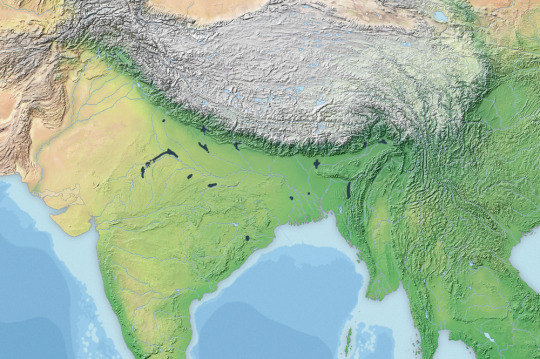

However when you look at how the range was meant to be like, then you see that they definitely reached the river deltas and coastal regions. So our image of gharials as this inland freshwater species is more based in circumstance than reality.
This becomes especially apparent once you begin to consider the paleobiogeography of gharials. Based on our current knowledge, gharials most likely originated somewhere in Eurasia or Africa, spreading from there across much of the eastern hemisphere and beyond (full disclosure I am not considering thoracosaurs to be gavialoids, more on that can of worms later maybe). Anywho, phylogenetic analysis and the fossil record both suggest that gharials then crossed oceans and settled South America sometime prior to or during the Miocene, where they diversified and gave rise to the gryposuchines. Some species even remained saltwater species, such as Piscogavialis, which lived in the coastal waters of Peru.
Although gryposuchines were once thought to be a distinct subfamily of gharial, recent research suggests that they were but an evolutionary stepping stone, with some South American form once again crossing the Pacific and settling down in Asia where the much more basal "tomistomines" or false gharials (a misnomer) still resided. And while the gryposuchines of South America went extinct, those that returned to Asia survived and eventually gave rise to the Indian Gharial of today.
Left: A cladogram showing the relationship between Gryposuchinae and modern gharials
Right: Piscogavialis swimming overhead some marine sloths of the genus Thalassocnus by @knuppitalism-with-ue


So ultimately, seeing a gharial in saltwater is much less bizarre than one would initially think, its just that habitat destruction and overhunting have largely pushed these gorgeous reptiles further inland and to the brink of extinction.
#gharial#indian gharial#gavialis gangeticus#gavialidae#news#croc#crocodilia#crocodile#india#herpetology#gavialinae#gryposuchinae#piscogavialis#some paleontology#palaeoblr
239 notes
·
View notes